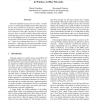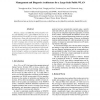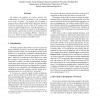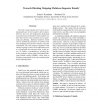WOWMOM
2006
ACM
14 years 6 months ago
2006
ACM
Abstract— A sybil node impersonates other nodes by broadcasting messages with multiple node identifiers (ID). In contrast to existing solutions which are based on sharing encryp...
WOWMOM
2006
ACM
14 years 6 months ago
2006
ACM
RTS-CTS handshake based protocols achieve “reliable unicast” by eliminating the hidden node problem effectively, however, these solutions are not directly or efficiently gene...
WOWMOM
2006
ACM
14 years 6 months ago
2006
ACM
Opportunistic scheduling can significantly improve wireless network performance by exploiting the feedback information that conveys the underlying channel condition. In emerging ...
WOWMOM
2006
ACM
14 years 6 months ago
2006
ACM
In Korea, a large-scale IEEE 802.11b-based public wireless LAN (WLAN) service, called NESPOT, has been in operation by Korea Telecom (KT) across the country during the last four y...
WOWMOM
2006
ACM
14 years 6 months ago
2006
ACM
This paper describes a biologically-inspired architecture, called SymbioticSphere, which allows large-scale server farms to autonomously adapt to dynamic environmental changes and...
WOWMOM
2006
ACM
14 years 6 months ago
2006
ACM
We address the problem of wireless stations selfconfiguration in a WLAN environment with overlapping access point coverages. We propose and investigate a transport-layer solution...
WOWMOM
2006
ACM
14 years 6 months ago
2006
ACM
This paper studies a Bad Apple phenomenon caused by Head-of-Line blocking in IEEE 802.11 networks. This problem can adversely affect the performance of wireless multimedia streami...
WOWMOM
2006
ACM
14 years 6 months ago
2006
ACM
Electronic mails (emails) have become an indispensable part of most people’s daily routines. However, they were not designed for deployment in an adversarial environment, which ...
WOWMOM
2006
ACM
14 years 6 months ago
2006
ACM
We present our experience with designing, developing, and deploying of an Internet accessible wireless sensor network for monitoring temperature, humidity, and illumination of a c...
WOWMOM
2006
ACM
14 years 6 months ago
2006
ACM
Sensors: Abstracting Data from Physical Sensors TR-UTEDGE-2006-001 Sanem Kabadayi Adam Pridgen Christine Julien © Copyright 2006 The University of Texas at Austin




